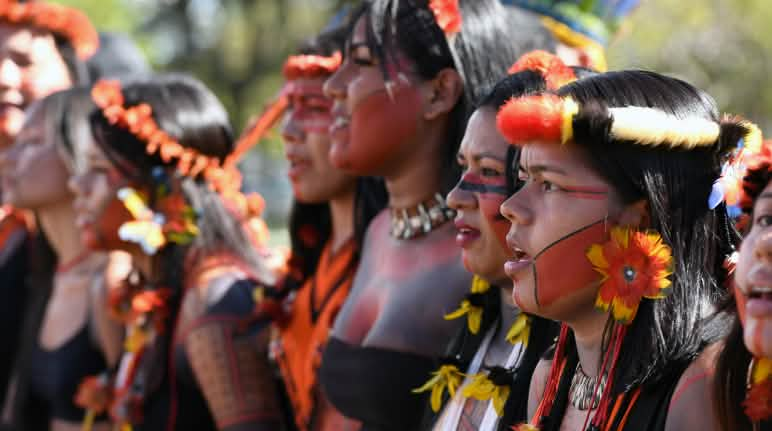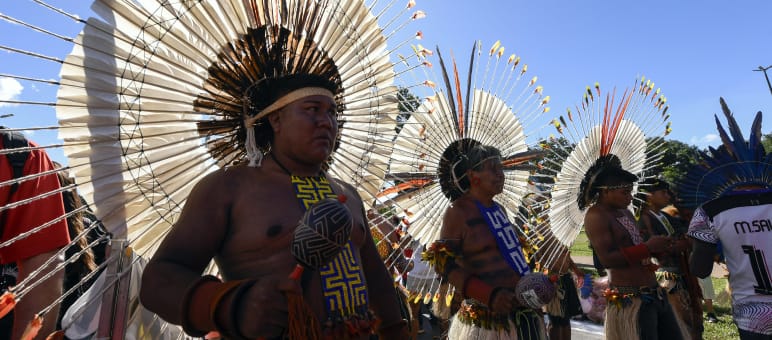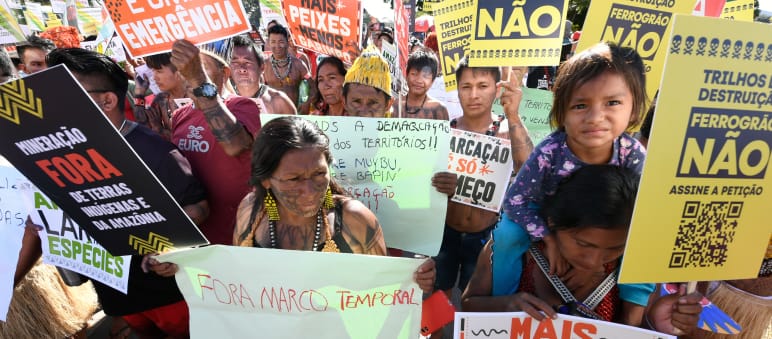Brazil: All land is Indigenous, all property is colonial
In the 16th century, the Portuguese Pero Vaz de Caminha took possession of what is now Brazil – including the Indigenous peoples who lived there – for the Portuguese crown. Since then, the people have been fighting against injustice, land grabbing, violence and death. Every April, they hold the “Free Land” camp in the capital, Brasilia, to demand the recognition of all their ancestral territories.
On May 1, 1500, the scribe Pero Vaz de Caminha sent a long letter to the Portuguese king, reporting “the discovery of this new land of yours”. Caminha described the land where he and 1,500 other men, including fleet commander Pedro Álvares Cabral, had landed with 13 ships eight days earlier, on April 22, and attributed it to the Portuguese crown.
The “new land” was actually called Pindorama and had been inhabited since time immemorial by almost three million people from various Indigenous tribes. So it was not a discovery, but a violent invasion by the Portuguese crown, which later renamed the area Brazil.
Caminha's letter reporting the “discovery” is the first document that falsifies the ownership of the territories inhabited by the Indigenous peoples of Pindorama. On the basis of this document, all subsequent false titles of ownership were created, “legalized” on paper by the logic of the European legal system and legitimized by the narrative of “conquest”. Over the centuries, the invaders brutally imposed this “logic” on the Indigenous peoples and later on the enslaved peoples from Africa.
Since the 1500s, Indigenous peoples who resisted genocide and systematic plunder by the Portuguese, Spanish, French and Dutch have struggled for the right to remain in their ancestral lands, or to return to them if they had been displaced and forced to seek refuge in foreign territories or on the outskirts of large urban centers.
Article 231 of the Brazilian Constitution of 1988 recognizes the “original rights of Indigenous peoples to the lands they have traditionally inhabited”. This means that their rights predate the creation of the state and the concept of “law”. However, according to the logic of the prevailing legal system, it is not enough for Indigenous peoples to be the original owners of their ancestral lands in order to be safe there. Article 231 of the Constitution states that it is the responsibility of the state to demarcate these territories, protect them and ensure that all their property is respected.
But this is not the case.
Less than one percent of the population
The process of demarcating Indigenous territories in Brazil is bureaucratic and lengthy and can drag on for decades without any steps being taken toward completion. According to the Brazilian government, there are currently 736 registered Indigenous territories in Brazil. Of these, 477 have been fully legalized, while the remaining 259 are in various stages of the arduous legalization process. In addition, many demarcation processes have not yet begun and are not included in the above figures.
The consequences of the theft and plunder of Indigenous lands over the centuries are reflected in the small number of members of these peoples who have managed to survive to this day. According to the 2022 census, there are now 305 Indigenous peoples in Brazil, with a total of 1.7 million individuals who identify themselves as Indigenous. This figure represents only 0.83 percent of Brazil’s population of more than 215 million people.
Intentional slowness
The slow and inefficient process of demarcating Indigenous lands is no accident. It corresponds to the interests of the descendants of the first invaders – today politicians, judges and members of the business elite – who want to continue to control and own the land that their ancestors conquered, stole and left as a legacy through false documents.
Between 2019 and 2021, during the far-right government of Jair Bolsonaro, the National Indian Foundation (FUNAI), the federal agency in charge of demarcation, was headed by the federal police delegate Marcelo Xavier, who did not identify, declare or homologate a single Indigenous land and deliberately delayed demarcation processes already underway.
As long as their lands are not demarcated, Indigenous peoples in Brazilian territory will continue to be violated, displaced and exterminated in various ways, including by rural militias financed by politicians who act with the same brutality as the first invaders, their ancestors.
“Free Land” protest camp
Despite all the opposing forces, the struggle for the ancestral lands of Indigenous peoples is gaining momentum these days, both in the countryside and in the cities.
It is most clearly expressed in public during Indigenous April, a month of protests, celebrations and commemorations in which the Indigenous population takes center stage in the streets, squares and the Brazilian press.
One of the most important events of the month is the “Free Land” protest camp (ATL), a nationwide mobilization of thousands of Indigenous people from different tribes. The ATL, which celebrated its 20th anniversary in 2024, takes place for a week in Brasilia, the country’s capital and seat of the federal government and legislature.

In caravans from different parts of Brazil, representatives of hundreds of Indigenous peoples take to the streets and public squares before the federal authorities to demand their rights, share struggles and strategies, celebrate achievements and their diverse cultures, and tell the government that Indigenous rights are non-negotiable.
Year after year, the main demand of the Indigenous peoples who gather at the ATL is for land and territory where the present, the past and also the future have their origins. “Our boundary stone is ancient. We’ve always been here” is the motto of this twentieth camp.
From this historical perspective, there is a continuity from the invasion of 1500 to the present day. And if the origin of all land belongs to the Indigenous people, then all claims to property are the result of the invasions of the colonizers.
MINISTÉRIO DA CULTURA, Fundação Biblioteca Nacional, Departamento Nacional do Livro. A CARTA DE PERO VAZ DE CAMINHA: https://objdigital.bn.br/Acervo_Digital/livros_eletronicos/carta.pdf
Fundação Nacional dos Povos Indígenas (FUNAI), Nov. 8, 2023. Demarcação: https://www.gov.br/funai/pt-br/atuacao/terras-indigenas/demarcacao-de-terras-indigenas#:~:text=Atualmente%2C%20constam%20736%20terras%20ind%C3%ADgenas,biomas%2C%20sobretudo%20na%20Amaz%C3%B4nia%20Legal.&text=Al%C3%A9m%20disso%2C%20h%C3%A1%20cerca%20de,an%C3%A1lise%20no%20%C3%A2mbito%20da%20Funda%C3%A7%C3%A3o.
Fundação Nacional dos Povos Indígenas (FUNAI), Aug. 7, 2023. Dados do Censo 2022 revelam que o Brasil tem 1,7 milhão de indígenas: https://www.gov.br/funai/pt-br/assuntos/noticias/2023/dados-do-censo-2022-revelam-que-o-brasil-tem-1-7-milhao-de-indigenas#:~:text=O%20levantamento%20aponta%20que%20a,83%25%20do%20total%20de%20habitantes.
Articulação dos Povos Indígenas do Brasil (APIB), 2022. Raio X Marcelo Xavier: https://apiboficial.org/foraxavier/
Brasil de Fato, Jan. 30, 2024. ‘Invasão Zero’: quem está por trás do grupo investigado pela morte de Nega Pataxó: https://www.brasildefato.com.br/2024/01/30/invasao-zero-quem-esta-por-tras-do-grupo-investigado-pela-morte-de-nega-pataxo
Articulação dos Povos Indígenas do Brasil (APIB), 2024. Acampamento Terra Livre 2024:https://apiboficial.org/atl2024/

